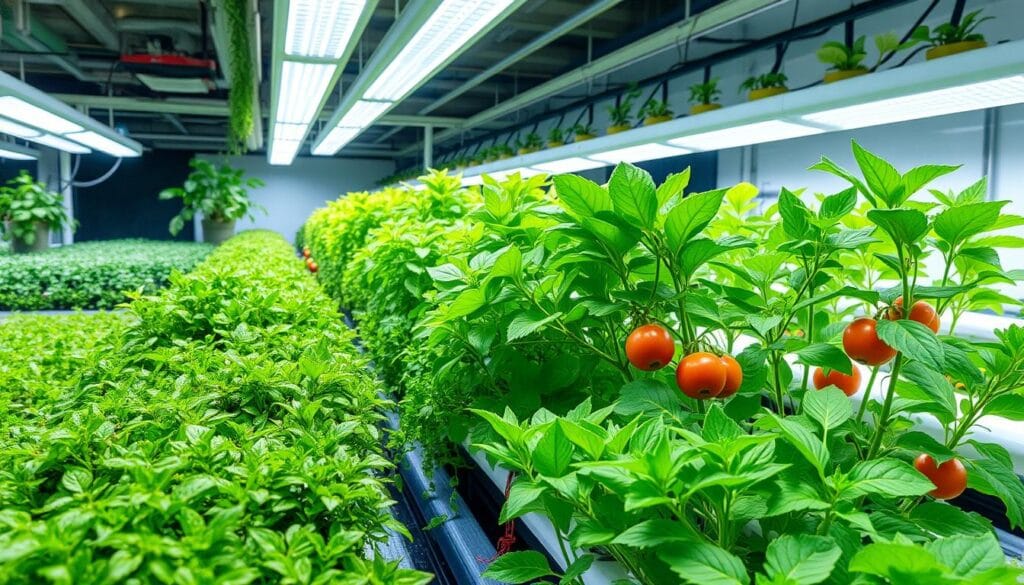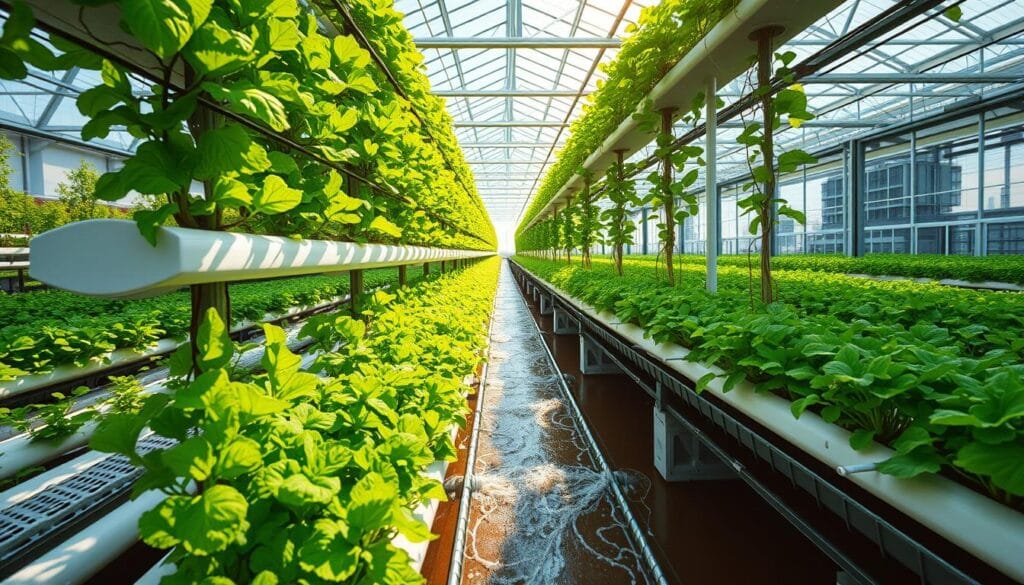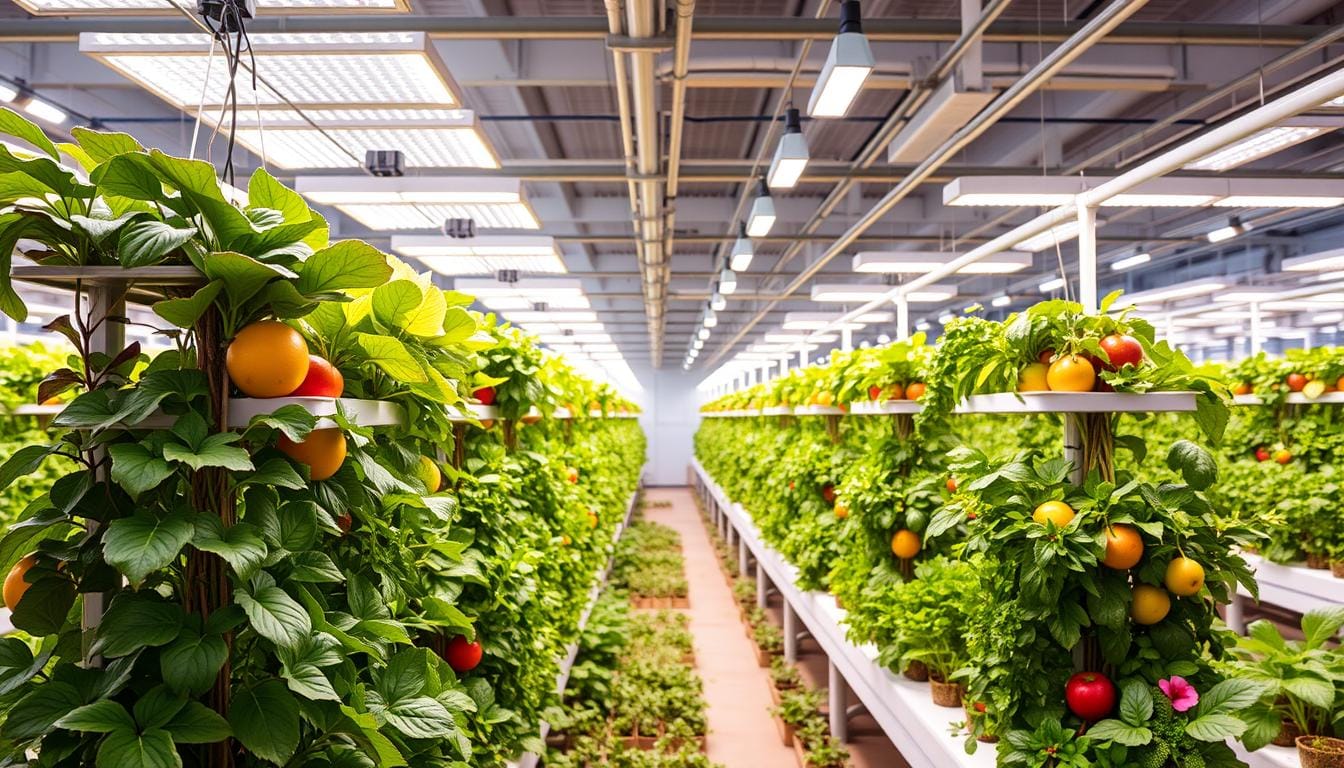wastesLooking to boost your farm? Hydroponic food production might be the answer. It grows plants in a nutrient-rich solution, not soil. This method is popular for its ability to increase yields and save water.
Hydroponic farming also helps the environment. It improves crop quality and reduces harm to the planet. This makes it a great choice for those wanting to farm sustainably.
Using hydroponic food production makes your farm more sustainable. It cuts down on environmental harm while boosting crop quality and yield. You can grow crops all year, no matter the season, and move away from old farming ways.
Key Takeaways
- Hydroponic food production involves growing plants in a nutrient-rich solution instead of soil.
- Hydroponic farming can increase crop yields and reduce water usage.
- Hydroponic food production promotes sustainable agriculture and reduces environmental impact.
- Hydroponic farming allows for year-round crop growth, regardless of the season.
- Hydroponic food production can improve crop quality and reduce the need for traditional farming methods.
- Hydroponic farming is a key component of sustainable agriculture, providing many benefits for modern farming operations.
Understanding Hydroponic Food Production: A Modern Farming Revolution
Exploring hydroponic gardening opens up a world of benefits. It involves growing plants in a controlled space, like a greenhouse, using a nutrient-rich solution instead of soil. This farming method is part of controlled environment agriculture, which lets you control temperature, humidity, and light precisely.
In indoor hydroponics, plants grow in a controlled space, away from outside factors that can harm them. A hydroponic system has a reservoir, pump, and irrigation system. The science behind it is simple: plants can get nutrients through their roots, no matter the growing medium.
What Makes Hydroponics Different from Traditional Farming
Hydroponic gardening has many advantages over traditional farming. Some key benefits include:
- Increased crop yields
- Water conservation
- Reduced land use
- Improved crop quality
Learning about hydroponic food production helps you make smart choices for your farm. Whether you’re an experienced farmer or just starting, hydroponic gardening is worth exploring.
Maximizing Crop Yields Through Controlled Environment Agriculture
Exploring hydroponic farming reveals the importance of controlled environment agriculture. It optimizes temperature, humidity, and light for plant growth. This method allows for year-round production, making farming more efficient and sustainable.
In controlled environment agriculture, you can precisely control conditions for healthy plants. You monitor and adjust CO2 levels, nutrient delivery, and pruning. This boosts crop yields and reduces waste, making farming more profitable and eco-friendly.
Some key benefits include:
- Increased crop yields
- Improved crop quality
- Reduced water and nutrient usage
- Minimized environmental impact
Hydroponic farming is a sustainable practice. It helps meet the growing global food demand. Innovative farming methods are key to sustainability and high crop yields.
| Factor | Controlled Environment Agriculture | Traditional Farming |
|---|---|---|
| Crop Yields | Increased | Variable |
| Water Usage | Reduced | High |
| Nutrient Usage | Optimized | Excessive |
Water Conservation and Resource Efficiency Benefits
Exploring hydroponic food production reveals big wins for water and resources. Hydroponics uses a closed-loop system, recycling nutrients and cutting down on water waste. This is great for farmers who care about water, as it uses much less than traditional farming.
Hydroponic food production is a big water saver. It controls water use and cuts down on evaporation. This not only saves water but also lessens the environmental harm of farming. Hydroponics achieves this through:
- Recycling nutrients to minimize waste
- Using efficient irrigation systems to reduce water usage
- Implementing closed-loop systems to conserve water
Choosing hydroponic food production helps make our food system more sustainable. It saves water and boosts resource use. As you dive into hydroponics, you’ll learn about reducing environmental impact. This includes using nutrient recycling and efficient irrigation systems.
Hydroponic food production is a great choice for saving water and resources. Its closed-loop system and efficient irrigation make it appealing to eco-conscious farmers. By going hydroponic, you’re helping build a greener food future.
| Method | Water Usage | Resource Efficiency |
|---|---|---|
| Hydroponic Food Production | Low | High |
| Traditional Farming | High | Low |
Year-Round Growing Capabilities and Climate Independence
Hydroponic gardening lets you grow plants year-round, no matter the season or weather. This is great for farmers in areas with bad weather or short growing seasons. You can control the environment to grow high-quality crops every day of the year.
Indoor hydroponics gives you the chance to grow many different crops. You can grow leafy greens, tomatoes, and even herbs. The secret to year-round growing is to give your plants the right light, water, and nutrients.

- Increased crop yields
- Improved crop quality
- Reduced water usage
- Year-round growing capabilities
By using indoor hydroponics, you can enjoy these benefits. You’ll consistently enjoy a continuous harvest of nutritious and wholesome food throughout the entire year.
Space Optimization and Vertical Farming Integration
Exploring hydroponic food production reveals the value of space optimization and vertical farming. This method lets you grow more in less space, perfect for city farmers. It boosts crop yields and uses space wisely.
Key points for optimizing space include:
- Check your space and plan the best layout for your hydroponic setup.
- Use vertical farming methods like trellises or wall systems to grow more.
- Choose space-saving tech, like LED grow lights, to cut down on space use.
Urban farming is a big part of space optimization and vertical farming. It brings fresh, local produce to city folks. It also cuts down on the environmental harm of old farming ways.
Maximizing Growing Area in Limited Spaces
To grow more in less space, mix hydroponic and vertical farming. Try a nutrient film technique (NFT) or an ebb-and-flow system. These methods deliver nutrients right to the plants’ roots. With the right space use and tech, you can thrive in the city.
Vertical Farming Techniques and Technologies
Vertical farming is always getting better, with new tech and ideas popping up. Artificial intelligence and machine learning are leading the way. They help grow more food and waste less. Keep up with these advancements to lead in hydroponic farming.
Enhanced Crop Quality and Nutritional Value
Exploring hydroponic food production reveals its power to boost crop quality and nutritional value. Hydroponics controls the environment for optimal growing conditions. This leads to high-quality crops with more nutrients.
Hydroponic systems reduce pesticide use and ensure consistent crop quality. They also allow for precise nutrient delivery to plants. This results in produce with better nutritional value and crop quality.
Some key benefits of hydroponic food production include:
- Increased crop yields and faster growth rates
- Improved crop quality and nutritional value
- Reduced water and land usage
- Year-round growing capabilities
Adopting hydroponic methods helps create a sustainable food system. It offers high-quality, nutritious produce for both commercial farmers and home growers. Hydroponics is a reliable and efficient way to grow healthy crops.
As demand for sustainable and nutritious food grows, hydroponics becomes more important. It offers many benefits, including better crop quality and nutritional value. Hydroponics is a great choice for a sustainable food future.
Pest Management and Reduced Chemical Usage
In hydroponic gardening, keeping pests away is key to a healthy crop. Using fewer chemicals helps avoid pests and diseases. This makes your garden better for the planet and your food healthier.
Some good ways to manage pests in hydroponic gardens include:
- Integrated Pest Management (IPM) techniques, which involve monitoring and controlling pest populations using a combination of methods
- Biological control, which uses natural predators or parasites to control pest populations
- Cultural controls, such as adjusting temperature, humidity, and light levels to prevent pest infestations
Using these methods helps you use fewer chemicals. This keeps your garden balanced and supports a sustainable food system.
Keeping your garden clean is also important. Regular checks and upkeep can catch problems early. This keeps your crop healthy and thriving.
| Pest Management Method | Description |
|---|---|
| Integrated Pest Management (IPM) | A combination of techniques to monitor and control pest populations |
| Biological Control | Using natural predators or parasites to control pest populations |
| Cultural Controls | Adjusting temperature, humidity, and light levels to prevent pest infestations |
Economic Advantages of Commercial Hydroponic Operations
Thinking about starting a hydroponic farm? It’s key to know the economic perks of commercial hydroponics. This method cuts down on labor costs, boosts crop yields, and uses resources better. These benefits make hydroponics a great choice for big farms.
Starting a hydroponic farm means looking at initial costs like equipment, setup, and staff. But, with smart planning, hydroponics can pay off big time. The main economic pluses of commercial hydroponics are:
- More crops and less waste
- Better use of water and nutrients
- Less labor needed and better workplaces
- Good long-term returns and market chances
Big hydroponic farms can also grab market chances. They can sell fresh produce to local shops and eateries. Knowing the economic benefits of hydroponics helps you make smart choices for your farm. This way, you can make more money.

In short, hydroponics has many economic benefits for big farms. These include lower labor costs, more crops, and better use of resources. By understanding these benefits and planning well, you can do well in the competitive world of commercial hydroponics.
| Benefits | Description |
|---|---|
| enhanced crop production | Hydroponic farming enables higher crop yields while minimizing waste. |
| Improved resource efficiency | Hydroponic farming improves resource efficiency, including water and nutrients. |
| Reduced labor costs | Hydroponic farming reduces labor costs and improves working conditions |
Conclusion: Embracing the Future of Sustainable Agriculture
Exploring hydroponic food production shows its huge promise for a greener food system. By adopting this advanced farming method, you join a group of innovators. They aim to lessen their environmental footprint and support sustainable farming.
Looking ahead, hydroponic farming offers many advantages. It boosts crop yields and cuts down water use. It also improves crop quality and nutritional value. This method is set to change how we grow and eat food.
As you dive deeper into hydroponic farming, you’ll see its power. It’s a chance to build a food system that’s both strong and kind to our planet. This system will meet the needs of our changing world.

